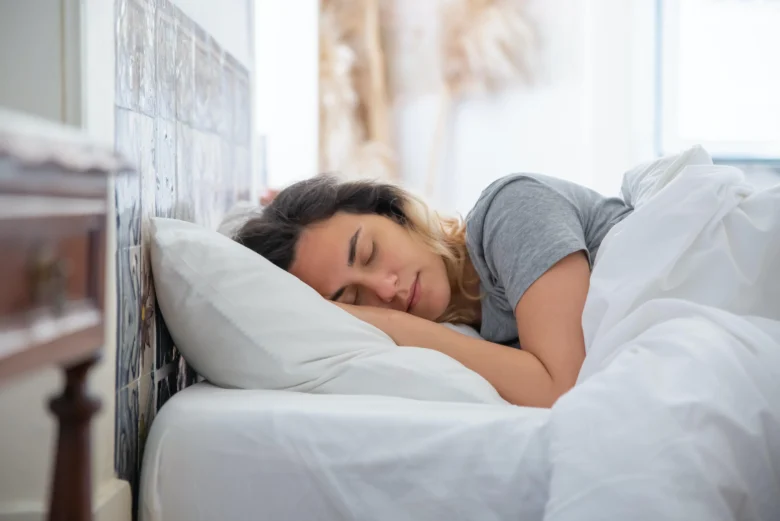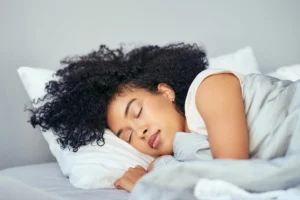Introduction to Sleep and Its Importance
Sleep is a fundamental component of human health, playing a vital role in physical and mental restoration. Despite being a biologically necessary process, sleep is often overlooked in today’s fast-paced society. Understanding the various stages of sleep and their contributions to our well-being can illuminate why prioritizing sleep is essential for a healthy lifestyle.
Sleep is divided into several stages, including REM (Rapid Eye Movement) and non-REM sleep. Non-REM sleep itself is further segmented into three stages: N1, N2, and N3. The lightest stage, N1, serves as a transition between wakefulness and sleep, while N2 accounts for approximately 50% of total sleep time, characterized by decreased heart rate and body temperature. N3, also known as deep sleep, is crucial for physical recovery, facilitating the body’s repair processes, growth, and immune function. Conversely, REM sleep is predominant during dreaming and plays an integral role in memory consolidation and cognitive processing.
The significance of quality sleep extends beyond mere rest; it is indispensable for productivity and mood regulation. Lack of adequate sleep can result in impairments in attention, decision-making, and problem-solving abilities, which can negatively affect daily performance. Furthermore, sleep influences emotional regulation. Inadequate sleep often contributes to increased stress levels, anxiety, and predisposition to mood disorders.
Long-term effects of poor sleep quality can lead to various health complications, including obesity, diabetes, cardiovascular diseases, and decreased life expectancy. As such, a commitment to improving sleep hygiene is vital. Everyone deserves restorative sleep, which is foundational to maintaining physical and mental health. With continuous research underscoring these connections, fostering healthy sleep habits can profoundly impact one’s overall quality of life.
The Impact of Caffeine, Diet, and Lifestyle on Sleep
Sleep quality is influenced by various lifestyle choices, including caffeine consumption, dietary habits, and daily routines. Caffeine, a stimulant found in coffee, tea, chocolate, and various sodas, can significantly impede the body’s ability to fall asleep and maintain restful slumber. It is well established that caffeine can remain in the system for several hours, meaning that consumption even in the early afternoon can lead to difficulties in falling asleep at night. For individuals seeking to improve their sleep patterns, it is advisable to limit caffeine intake, particularly in the hours preceding bedtime.
Dietary choices also play a crucial role in sleep quality. Certain foods promote better sleep by providing essential nutrients that help the body prepare for rest. Foods rich in magnesium, such as leafy green vegetables, nuts, and seeds, can facilitate deeper sleep. Additionally, foods containing tryptophan, like poultry, dairy products, and bananas, have been linked to increased melatonin production, a hormone that regulates sleep. On the other hand, heavy or spicy meals close to bedtime can lead to discomfort and disruptive sleep disturbances, ultimately detracting from restorative sleep.
Beyond caffeine and diet, lifestyle habits are paramount in determining sleep quality. Establishing a consistent sleep schedule can greatly assist in regulating the body’s internal clock, enabling more restful sleep. Furthermore, engaging in relaxing activities before bed, such as gentle yoga or meditation, can help mitigate stress and anxiety, reducing the likelihood of sleep disturbances. Creating a conducive sleep environment by controlling light and noise levels is also crucial. By adopting healthier lifestyle choices and being mindful of consumption patterns, individuals can significantly enhance their sleep quality and overall well-being.
Understanding Yoga and Its Benefits for Sleep
Yoga, an ancient practice that encompasses physical postures, breathing techniques, and meditation, offers a comprehensive approach to enhancing sleep quality. Through a combination of these elements, yoga can help individuals attain a state of relaxation conducive to sleep. The physical benefits of yoga, such as improved flexibility and reduced muscle tension, play a significant role in fostering better sleep. By engaging in gentle yoga stretches, practitioners can alleviate stress and promote circulation, which often leads to a more restful night.
Moreover, the mental advantages of yoga cannot be overstated. The practice encourages mindfulness and fosters a deep body awareness that allows individuals to tune into the present moment. This engagement with the present can help diminish racing thoughts that commonly hinder sleep. Techniques such as focused breathing and meditation during yoga sessions cultivate a sense of calm, reducing anxiety levels that may otherwise affect one’s ability to fall asleep. By creating a serene mental space, yoga acts as a powerful tool for those struggling with insomnia or disrupted sleep patterns.
Emotionally, yoga contributes to better emotional regulation, which can significantly impact sleep quality. Individuals who regularly practice yoga often report experiencing less emotional reactivity and improved coping mechanisms in times of stress. This emotional balance is crucial for creating a conducive environment for sleep, as heightened stress levels can lead to insomnia and restless nights. Therefore, the incorporation of yoga into a nighttime routine can be especially beneficial; as it not only strengthens the body but also nourishes the mind and soul, enhancing overall well-being and sleep quality.
Meditation as a Tool for Sleep Enhancement
Meditation serves as a powerful tool for enhancing sleep quality, allowing individuals to cultivate a state of relaxation that can significantly improve their ability to fall asleep. Various meditation techniques can be employed to calm the mind and reduce the physical manifestations of stress, creating an optimal environment for sleep.
One popular method is mindfulness meditation, which emphasizes the importance of being present in the moment. By focusing on the breath and observing thoughts without judgment, individuals can develop a sense of detachment from their racing minds. This practice not only fosters relaxation but also helps to alleviate anxiety, making it easier to transition into a restful state conducive to sleep.
Another effective technique is guided imagery meditation. This approach involves visualizing calming scenes or positive experiences, steering the mind away from the stressors of the day. By immersing oneself in soothing imagery, practitioners can evoke a sense of peace, allowing the body to unwind and naturally progress toward sleep.
Body scan meditation is also beneficial for sleep enhancement. This method encourages participants to mentally check in with each part of their body, promoting physical relaxation by releasing tension stored in muscles. By systematically concentrating on different body segments, individuals can cultivate deeper awareness and relaxation, which may lead to improved sleep quality.
Incorporating meditation into a nightly routine can create a sense of consistency and signal to the body that it is time to unwind. Establishing such habits can facilitate restorative sleep, crucial for overall health and well-being. Therefore, experimenting with different meditation techniques may aid individuals in discovering what resonates best, ultimately fostering a more profound transition into sleep.
Effective Yoga Poses for Better Sleep
Practicing yoga can be a powerful tool for enhancing sleep quality and promoting relaxation. Certain poses are particularly effective in alleviating tension and calming the nervous system, thereby preparing the body for restorative rest. This section explores several yoga poses known to help improve sleep quality by fostering tranquility and easing physical discomfort.
One of the most beneficial poses for sleep is Child’s Pose (Balasana). This restful asana encourages deep breathing and helps to release tension in the back, neck, and shoulders. It is a grounding position that calms the mind while providing a gentle stretch to the spine. By bending forward and allowing the forehead to rest on the mat, individuals can stimulate the parasympathetic nervous system, which aids in relaxation and mental clarity.
Another effective pose is the Legs Up the Wall Pose (Viparita Karani), which involves lying on your back with your legs elevated against a wall. This pose facilitates relaxation by promoting venous return and decreasing anxiety. By inversing the body, it also helps to relieve fatigue in the legs while calming the mind, making it an excellent choice for winding down before bed.
Reclining Bound Angle Pose (Supta Baddha Konasana) is a further pose that encourages deep relaxation. By lying back with the soles of the feet together and knees spread apart, this position opens the hips while allowing the chest to expand. The gentle stretch can help release stored tension, enabling the body to transition into a restful state effectively.
Finally, Corpse Pose (Savasana) is often used as a final resting pose in yoga practice. This asana encourages deep relaxation and mindfulness. By lying flat on the back with arms at the sides and focusing on the breath, individuals can let go of the day’s stresses, facilitating profound rest and promoting better sleep quality.
Guided Meditations for a Restful Night
Guided meditation has emerged as an effective practice to enhance the quality of sleep and promote overall relaxation. By utilizing audio recordings or written scripts, practitioners can facilitate a smoother transition into slumber. These meditations are designed to prepare both the mind and body for rest, helping to reduce the mental chatter and physical tension that often accompany insomnia.
One approach to guided meditation involves listening to pre-recorded sessions, which can be easily accessed through various apps or websites. These recordings typically feature a soft-spoken guide who leads the participant through a series of calming visualizations and breathing exercises. Incorporating these audio meditations into a nightly routine can significantly enhance the preparatory process for sleep. It is advisable to select a quiet space free of distractions, allowing the mind to fully immerse in the experience.
For those who prefer a more personalized touch, written scripts offer a valuable alternative. These scripts can be read aloud before bedtime, allowing practitioners to engage with the content actively. The act of reading not only cultivates mindfulness but also reinforces the relaxation response necessary for effective sleep. Additionally, creating a dedicated “sleep ritual” that includes guided meditation fosters consistency and signals to the body that it is time to unwind.
To maximize the benefits of guided meditation for sleep, it is recommended to keep the sessions between 10 to 20 minutes long, focusing on themes of relaxation, gratitude, and letting go of the day’s stressors. Experimenting with different formats can help identify the most effective meditation style for the individual. By regularly incorporating guided meditations into bedtime practices, individuals may discover a more restorative and peaceful sleep experience.
Breathing Techniques to Calm the Mind
Integrating breathing techniques into your nightly routine can significantly enhance relaxation and prepare your body for restful sleep. Among the most effective methods are diaphragmatic breathing, 4-7-8 breathing, and alternate nostril breathing, each offering unique physiological benefits that promote calmness and reduce anxiety.
Diaphragmatic breathing, also known as abdominal breathing, focuses on engaging the diaphragm rather than the chest. To practice this technique, find a comfortable position, either sitting or lying down. Place one hand on your chest and the other on your abdomen. Inhale deeply through your nose, ensuring that your abdominal hand rises while your chest remains relatively still. This method encourages full oxygen exchange, which activates the body’s relaxation response, lowering heart rate and blood pressure.
The 4-7-8 breathing technique is specifically designed to help you relax before bed. Begin by exhaling fully through your mouth, then close your lips and inhale quietly through your nose to a count of four. Hold this breath for a count of seven, and then exhale through your mouth to a count of eight. This pattern can be repeated four times. This method helps clear the mind, reduces tension, and prepares the body for sleep by balancing the sympathetic and parasympathetic nervous systems.
Lastly, alternate nostril breathing, or Nadi Shodhana, is a powerful practice in yoga and meditation that balances energy within the body. To perform this technique, sit comfortably and use your right thumb to close your right nostril. Inhale deeply through your left nostril, then close it with your right ring finger and exhale through the right nostril. Inhale through the right nostril, close it, and exhale through the left nostril. This cycle can be repeated for several minutes and is known to alleviate stress, enhance mental clarity, and promote overall well-being.
Incorporating these breathing techniques into your pre-sleep routine can not only improve the quality of your sleep but also establish a tranquil atmosphere conducive to relaxation and restoration.
Creating a Sleep-Inducing Environment
Creating a sleep-inducing environment is essential for enhancing the quality of restorative sleep. The atmosphere of a bedroom can significantly impact one’s ability to fall and stay asleep. A primary consideration is lighting; using dimmable lights or warm-toned lamps can help signal to the body that it is time to wind down. It is advisable to minimize exposure to artificial bright lights, especially blue light, in the hours leading up to bedtime. Blackout curtains can also be advantageous in blocking out external light sources that may disrupt sleep.
Noise control is another critical factor. A peaceful sleeping environment can be achieved by either eliminating disruptive sounds or masking them with soothing background noise. White noise machines, fans, or soft music can create a calming atmosphere conducive to sleep. Ensuring that windows are closed can help reduce outside noise, and earplugs may be beneficial for those particularly sensitive to sound disturbances.
Furthermore, selecting the right mattress and bedding is paramount for comfort and relaxation. A mattress that offers the right balance of firmness and support can prevent physical discomfort that may interrupt sleep. Additionally, the type of bedding, including pillows and blankets, should promote a comfortable and cozy environment for resting. Hypoallergenic materials can be considered for those with allergies that might adversely affect sleep quality.
Aromatherapy is an excellent complementary practice to enhance the sleep environment. Incorporating calming scents such as lavender, chamomile, or sandalwood can create a peaceful ambiance that promotes relaxation. Essential oil diffusers or calming scented candles can be strategically placed in the bedroom to evoke a tranquil atmosphere. By focusing on these elements—lighting, noise control, mattress selection, and aromatherapy—individuals can curate a sanctuary that supports better sleep and an overall sense of restoration.
Establishing a Consistent Sleep Routine with Yoga and Meditation
In the pursuit of better sleep and restoration, establishing a consistent nightly routine incorporating yoga and meditation can be remarkably effective. Regular practice not only promotes relaxation but also signals the body that it is time to wind down at the end of the day. To begin, it is essential to select specific times in the evening dedicated solely to yoga and meditation practices. By doing so, individuals can create a sense of predictability and structure that is conducive to improved sleep quality.
One practical approach is to designate a period of 30 minutes to 1 hour before bedtime for a calming yoga session. This can include gentle poses such as Child’s Pose, Legs-Up-the-Wall Pose, or Sukhasana (Easy Pose), which help to ease tension and calm the mind. Pairing these restorative postures with deep breathing techniques can further enhance relaxation, facilitating a smoother transition into sleep. It is advisable to keep the lighting low and use calming scents, such as lavenders or chamomiles, to create a soothing atmosphere.
Following the physical practice of yoga, spending the next 10 to 15 minutes on meditation can deepen the relaxation effect. Simple guided meditations focused on mindfulness, or breath awareness, can help clear the mind and foster emotional equilibrium. Listening to soft music or nature sounds during this practice can also enhance the experience, making it easier to let go of daily stressors. Consistency in these evening rituals is key; committing to this routine for several weeks can lead to enhanced benefits, allowing the body and mind to recognize cues for sleep.
Integrating yoga and meditation as nightly rituals not only aids in achieving restful sleep but also improves overall wellness. When practiced regularly, these techniques can cultivate a state of tranquility that encourages deeper sleep cycles and promotes restoration during the night. By prioritizing this consistent routine, individuals can significantly enhance their sleep quality and overall health.




